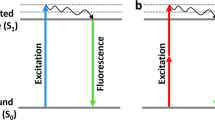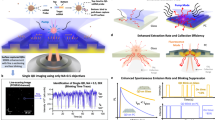Abstract
Semiconductor quantum dots are inorganic fluorescent nanocrystals that, because of their unique optical properties compared with those of organic fluorophores, have become popular as fluorescent imaging probes. Although external light excitation is typically required for imaging with quantum dots, a new type of quantum dot conjugate has been reported that can luminesce with no need for external excitation. These self-illuminating quantum dot conjugates can be prepared by coupling of commercially available carboxylate-presenting quantum dots to the light-emitting protein Renilla luciferase. When the conjugates are exposed to the luciferase's substrate coelenterazine, the energy released by substrate catabolism is transferred to the quantum dots through bioluminescence resonance energy transfer, leading to quantum dot light emission. This protocol describes step-by-step procedures for the preparation and characterization of these self-illuminating quantum dot conjugates. The preparation process is relatively simple and can be done in less than 2 hours. The availability of self-illuminating quantum dot conjugates will provide many new possibilities for in vivo imaging and detection, such as monitoring of in vivo cell trafficking, multiplex bioluminescence imaging and new quantum dot-based biosensors.
This is a preview of subscription content, access via your institution
Access options
Subscribe to this journal
Receive 12 print issues and online access
$259.00 per year
only $21.58 per issue
Buy this article
- Purchase on Springer Link
- Instant access to full article PDF
Prices may be subject to local taxes which are calculated during checkout




Similar content being viewed by others
References
Michalet, X. et al. Quantum dots for live cells, in vivo imaging, and diagnostics. Science 307, 538–544 (2005).
Medintz, I.L., Uyeda, H.T., Goldman, E.R. & Mattoussi, H. Quantum dot bioconjugates for imaging, labelling and sensing. Nat. Mater. 4, 435–446 (2005).
Jaiswal, J.K. & Simon, S.M. Potentials and pitfalls of fluorescent quantum dots for biological imaging. Trends Cell Biol. 14, 497–504 (2004).
So, M.-K., Xu, C., Loening, A.M., Gambhir, S.S. & Rao, J. Self-illuminating quantum dot conjugates for in vivo imaging. Nat. Biotechnol. 24, 339–343 (2006).
Wilson, T. & Hastings, J.W. Bioluminescence. Annu. Rev. Cell Dev. Biol. 14, 197–230 (1998).
Ward, W.W. & Cormier, M.J. Energy transfer via protein-protein interaction in Renilla bioluminescence. Photochem. Photobiol. 27, 389–396 (1978).
Pfleger, K.D.G. & Eidne, K.A. Illuminating insights into protein-protein interactions using bioluminescence resonance energy transfer (BRET). Nat. Methods 3, 165–174 (2006).
Sapsford, K.E., Berti, L. & Medintz, I.L. Materials for fluorescence resonance energy transfer analysis: beyond traditional donor-acceptor combinations. Angew. Chem. Int. Ed. Engl. 45, 4562–4589 (2006).
Loening, A.M., Fenn, T.D., Wu, A.M. & Gambhir, S.S. Consensus guided mutagenesis of Renilla luciferase yields enhanced stability and light output. Protein Eng. Des. Sel. 19, 391–400 (2006).
Huang, X., Li, L., Qian, H., Dong, C. & Ren, J. A resonance energy transfer between chemiluminescent donors and luminescent quantum-dots as acceptors (CRET). Angew. Chem. Intl. Ed. Engl. 45, 5140–5143 (2006).
Zhang, Y. et al. Halotag protein-mediated site-specific conjugation of bioluminescent proteins to quantum dots. Angew. Chem. Int. Ed. Engl. 45, 4936–4940 (2006).
De, A. & Gambhir, S.S. Non-invasive imaging of protein-protein interactions from live cells and living subjects using bioluminescence resonance energy transfer. FASEB J. 19, 2017–2019 (2005).
Acknowledgements
This work was supported by the Burroughs Wellcome Fund and the National Cancer Institute Centers of Cancer Nanotechnology Excellence (1U54CA119367-01).
Author information
Authors and Affiliations
Contributions
M.-K.S. did the conjugation and imaging experiments and prepared figures; A.M.L. prepared Luc8 and wrote the manuscript; S.S.G. provided discussions; and J.R. designed and coordinated research, analyzed data and wrote the manuscript.
Corresponding author
Ethics declarations
Competing interests
Stanford University is seeking to file a patent application covering part of the information contained in the paper.
Rights and permissions
About this article
Cite this article
So, MK., Loening, A., Gambhir, S. et al. Creating self-illuminating quantum dot conjugates. Nat Protoc 1, 1160–1164 (2006). https://doi.org/10.1038/nprot.2006.162
Published:
Issue Date:
DOI: https://doi.org/10.1038/nprot.2006.162
This article is cited by
-
Self-illumination of Carbon Dots by Bioluminescence Resonance Energy Transfer
Scientific Reports (2019)
-
Nanostructured biosensor using bioluminescence quenching technique for glucose detection
Journal of Nanobiotechnology (2017)
-
Near-infrared fluorophores for biomedical imaging
Nature Biomedical Engineering (2017)
-
Bioluminescent magnetic nanoparticles as potential imaging agents for mammalian spermatozoa
Journal of Nanobiotechnology (2016)
-
Application of quantum dot nanoparticles for potential non-invasive bio-imaging of mammalian spermatozoa
Journal of Nanobiotechnology (2012)
Comments
By submitting a comment you agree to abide by our Terms and Community Guidelines. If you find something abusive or that does not comply with our terms or guidelines please flag it as inappropriate.



